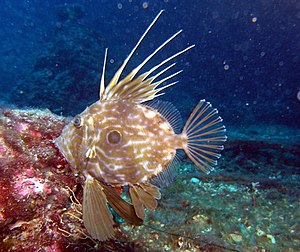Petersfish
| Petersfish | ||||||||||||
|---|---|---|---|---|---|---|---|---|---|---|---|---|

Petersfisch ( Zeus faber ) |
||||||||||||
| Systematics | ||||||||||||
|
||||||||||||
| Scientific name | ||||||||||||
| Zeus faber | ||||||||||||
| Linnaeus , 1758 |
The (St.) Petersfisch ( Zeus faber ), also known as Herring King , Sunfish , Christfish , Martinsfish or Saint-Pierre (French) or John Dory (English), is a sea fish and is up to 60 centimeters long and up to four kilograms in weight. In extreme cases, animals up to 90 centimeters and 20 kilograms have also been caught. In the wild it reaches an average age of around twelve years.
Appearance and Etymology
The Petersfisch has a heavily flattened and high-backed body. The head and eyes are large, the eyes are high, the mouth is tilted upwards. On the flanks of the otherwise gray to green-yellowish colored, irregularly spotted fish is a round, black, often yellow or yellowish white bordered spot. According to legend, this is a fingerprint of the apostle Peter . This is said to have pulled a piece of gold out of the fish's mouth. The anterior dorsal fin has remarkably long spiny rays that are only connected to the fin membrane in the lower area. The second, soft-radiating dorsal fin and the anal fin are symmetrical to each other. Gill trap rays are only rudimentary.
- Fin formula : dorsal IX – XI / 22–24, anal IV / 20–23.
distribution
The Petersfisch occurs in the East Atlantic in the area from South Africa to Norway , in the Mediterranean Sea , in the Black Sea , in the Indian Ocean and in the Pacific around Australia , Japan and New Zealand .
Multiplication
At the age of three to four years, St. Peter's fish becomes sexually mature. St. Peter's fish spawn off the coast of southern England from June to August and in the Mediterranean in spring. The spawning business happens in deep water. The eggs, which are about 2 mm in diameter, and the larvae are planktonic .
Way of life
The Petersfisch usually lives near the bottom at a depth of five to 200 meters and is a loner. It feeds mainly on schooling fish , especially herrings , which it first approaches carefully and then quickly sucks them in; the maxillary apparatus required for this is very well developed. Sometimes it also hunts invertebrates , especially octopuses and crustaceans .
use
The Petersfisch is an excellent food fish and is mostly caught with bottom trawls . In 2010 the global catch was over 10,000 tons, after increasing from around 1,000 tons to 12,000 tons between 1960 and 2000. The meat of St. Peter's fish can be steamed, fried, grilled, boiled and baked and is also processed into fish meal or fish oil .
literature
- Bent J. Muus, Jørgen G. Nielsen; Preben Dahlström and Bente Olesen Nyström (illustrations): The marine fish of Europe. In the North Sea, Baltic Sea and Atlantic (original title: Havfisk og fiskeri i Nordvesteuropa , translated by Matthias Stehmann), Franckh-Kosmos, Stuttgart 1999, ISBN 3-440-07804-3 .
- Matthias Bergbauer, Bernd Humberg: What lives in the Mediterranean? Franckh-Kosmos, Stuttgart 1999, ISBN 3-440-07733-0 .
Web links
- Petersfisch on Fishbase.org (English)
- Zeus faber on the FAO side
